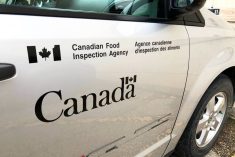New federal rules will more easily allow healthy breeding cattle to enter Canada from the U.S. if one or some of their herdmates test positive for anaplasmosis.
The Canadian Food Inspection Agency said it’s revised its import rules to bring the handling of “non-negative” U.S. animals more in line with the regulations that govern domestic Canadian cattle.
Currently, breeding cattle imported into Canada must have a negative test for anaplasmosis performed within 30 days of import. The test for anaplasmosis must be by cELISA methodology and conducted in a U.S. Department of Agriculture (or USDA-approved) laboratory.
Read Also

Canada, Philippines make African swine fever zoning agreement
Canada and the Philippines have signed an African swine fever (ASF) zoning arrangement, a measure that should ensure trade can continue between the countries during outbreak of the disease.
The result of anaplasmosis testing must be shown on the required health certificate for the animal to be imported, CFIA said.
Under the revised rules, however, if a cELISA test finds an animal carrying anaplasmosis, a polymerase chain reaction (PCR) test is then required.
If the PCR test results turns up negative on a cELISA-positive animal, all other animals that make up the export group may proceed for export.
But if the PCR test on an cELISA-positive animal has positive results, the animal will need to be removed from the export group and the remaining animals will need to be isolated and retested at least 35 days after the PCR-positive animal was removed from the group.
If all animals still in the group remain cELISA-negative after the 35-day isolation period, they may be exported, CFIA said.
Spread by ticks
The rules note that breeding cattle destined for import to Canada must be free of ticks and must have been treated with an appropriate acaracide within 30 days of import.
Anaplasmosis, a common ailment in cattle in tropical and sub-tropical regions of most of the world, is often spread by ticks that bite infected cattle.
Anaplasmosis is not a regulated disease in the U.S., but according to CFIA, Canadian officials continue to verify Canada’s anaplasmosis-free status through regular periodic testing of the national cattle herd and investigation of any suspected occurrence of the disease.
CFIA noted that its anaplasmosis requirements do not apply to animals imported from Hawaii.
The disease can be found in cattle, sheep, goats and deer but only causes clinical signs in cattle and giraffes, CFIA said. Those signs in cattle include fever, anemia, weakness and “respiratory distress,” plus a “rapid decline” in milk production from dairy cattle. The death rate can reach up to 29-49 per cent in cattle over two years old showing such clinical signs.
There is no human health risk associated with the disease, CFIA said.
Down to 48 hours
On a related note, CFIA also recently revised its rules for imports of domestic sheep and goats from the U.S.
Where previously an importer had no more than seven days to inform the appropriate CFIA district office of the import of feeder animals, the agency has now cut that requirement to no more than 48 hours.














